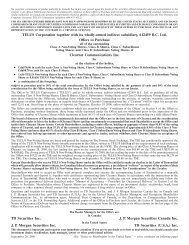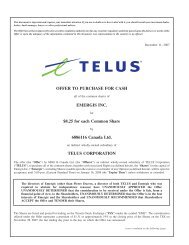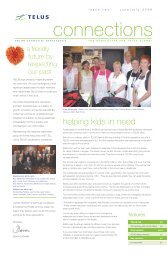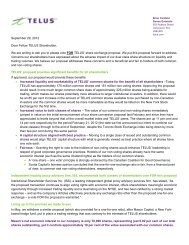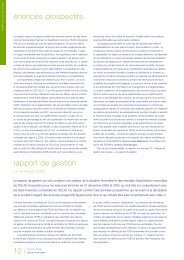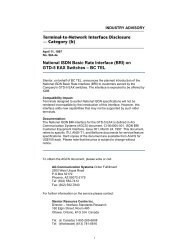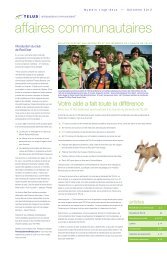Annual report - About TELUS
Annual report - About TELUS
Annual report - About TELUS
You also want an ePaper? Increase the reach of your titles
YUMPU automatically turns print PDFs into web optimized ePapers that Google loves.
3G: Third Generation, describes next generation wireless<br />
technology that is expected to be CDMA-based and offer<br />
high-speed packet data mobile wireless Internet access<br />
and multimedia communications. Analogue cellular is<br />
considered the First Generation of wireless while digital<br />
is Second Generation.<br />
ADSL (asymmetric digital subscriber line): A technology that<br />
allows existing copper telephone lines to carry voice, data<br />
and video images at very high speeds.<br />
Alberta.com: A news and information Website for Albertans.<br />
The site provides information on news, sports, entertainment,<br />
directories, maps and communication services.<br />
Analogue: A transmission method employing a continuous<br />
(rather than pulsed or digital) electrical signal.<br />
ARPM (average revenue per minute): For long distance traffic.<br />
ARPU (average revenue per unit): Average revenue per<br />
unit, or wireless subscriber, expressed as a rate per<br />
month for a given measurement period.<br />
ASP (application service provider): A company that<br />
offers individuals or enterprises access over the Internet<br />
to applications and related services that would otherwise<br />
have to be located in their own personal or enterprise<br />
computers.<br />
ATM (asynchronous transfer mode): A high-speed switching<br />
technology that routes voice, data and video at high<br />
speeds over the same network.<br />
Bandwidth: The difference between the top and bottom<br />
limiting frequencies of a continuous frequency band; or<br />
indicator of the information-carrying capacity of a channel.<br />
The greater the bandwidth, the greater the informationcarrying<br />
capacity.<br />
Bundle: A group of telecommunications services, i.e.<br />
Internet, long distance and calling features, that are sold<br />
together often at a lower price than if purchased separately.<br />
CDMA (code division multiple access): Technique that<br />
spreads a signal over a frequency band that is larger<br />
than the signal to enable the use of a common band by<br />
many users and to achieve signal security and privacy.<br />
See also IS-95 and CDMA2000.<br />
CDMA2000: A third-generation wireless standard, adopted<br />
by the International Telecommunications Union (ITU),<br />
which prescribes an evolutionary path to 3G for IS-95<br />
based systems. The first step in the CDMA2000 evolution<br />
after IS-95 is called 1XRTT. See also IS-95 and CDMA.<br />
CDPD (cellular digital packet data): A specification for<br />
supporting wireless access to the Internet and other<br />
public packet-switched networks.<br />
Cell site: Individual locations of network transmitter,<br />
receiver, antenna signaling and related base station<br />
equipment.<br />
Cellular: The mobile radio-telephone service, licensed<br />
by Industry Canada in Canada and the FCC in the<br />
United States to utilize 50 MHz of spectrum in the<br />
800 MHz band. There are two 25 MHz licensees<br />
operating in each region of Canada.<br />
Churn rate: The number of subscriber units disconnected<br />
divided by the average number of units on the<br />
network, expressed as a rate per month for a given<br />
measurement period.<br />
CRTC (Canadian Radio-television and Telecommunications<br />
Commission): The federal regulator for radio and television<br />
broadcasters, and cable-TV and telecommunications<br />
companies in Canada.<br />
Dial-up access: Connecting to another computer or<br />
network using a modem over a regular telephone line.<br />
Digital: A transmission method employing a sequence of<br />
discrete, distinct pulses that represent the binary digits<br />
0 and 1 to indicate specific information, in contrast to the<br />
continuous signal of analogue. Digital networks provide<br />
improved clarity, capacity, features and privacy compared<br />
to analogue systems.<br />
EBITDA: Earnings before interest, taxes and amortization.<br />
Under Canadian GAAP, amortization includes<br />
depreciation. In Canada, EBITA is equivalent to EBITDA.<br />
e-commerce: Refers to business conducted electronically,<br />
usually via the Internet.<br />
ESMR (enhanced specialized mobile radio): Specialized<br />
mobile radio networks that have incorporated frequency<br />
reuse and TDMA technology to increase their capacity<br />
and to provide service over very large coverage areas.<br />
An ESMR network is designed not only for the dispatch<br />
service associated with SMR, but also for mobile telephony<br />
and short messaging services, as well as circuitswitched<br />
and packet data services.<br />
Ethernet: A common method of networking computers<br />
in a local area network. Ethernet will handle about 10<br />
million bits-per-second and can be used with almost<br />
any kind of computer.<br />
Fibre network: Transmits information by light pulses along<br />
hair-thin glass fibres. Cables of optical fibres can be made<br />
smaller and lighter than conventional cables using copper<br />
wires or coaxial cable, yet they can carry much more<br />
information, making them useful for transmitting large<br />
amounts of data between computers or many simultaneous<br />
telephone conversations.<br />
Frame relay: A high-speed packet switching technology<br />
that has evolved to meet the LAN-to-LAN interconnection<br />
market. Frame relay is designed to provide high-speed<br />
packet transmission, very low network delay and efficient<br />
use of network bandwidth.<br />
GAAP: Generally accepted accounting principles.<br />
GHz: Gigahertz. See Hertz.<br />
GSM (Global System for Mobile Communications): A TDMAbased<br />
digital communications standard that has been<br />
widely deployed in Europe and around the world in the<br />
900 and 1800 MHz bands. A separate variant called PCS-<br />
1900 has been developed for use in the 1.9 GHz PCS<br />
frequency range in North America.<br />
Hertz: The dimensional unit for measuring the frequency<br />
with which an electromagnetic signal cycles through the<br />
zero-value state between lowest and highest states. One<br />
hertz (Hz) equals one cycle per second. KHz (kilohertz)<br />
equals one thousand hertz. MHz (megahertz) equals one<br />
million hertz. GHz (gigahertz) equals one billion hertz.<br />
iDEN (integrated digital enhanced network): An ESMR network<br />
technology developed by Motorola to utilize 800<br />
MHz SMR channels for ESMR digital service. The digital<br />
signals offer greatly enhanced spectrum efficiency and<br />
system capacity.<br />
> 93<br />
<<br />
glossary



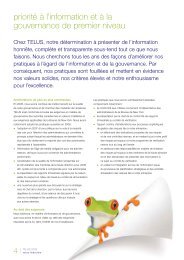
![DISK004:[98CLG6.98CLG3726]BA3726A.;28 - About TELUS](https://img.yumpu.com/16786670/1/190x245/disk00498clg698clg3726ba3726a28-about-telus.jpg?quality=85)
